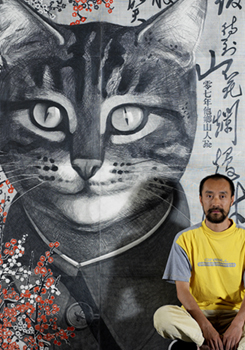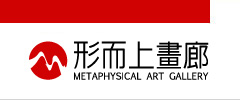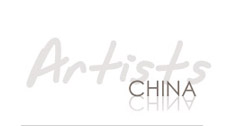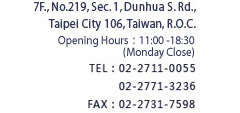|
 |
|
| |
 |
 |
 |
| |
On the noisy scene of contemporary art, Qiu Jie is not a well-known name. All the more with the pseudonym he has given himself, ¡§the man who comes from other mountains¡¨, this is not just humorous, but real and he lives as ¡§a sage¡¨ in Geneva. This pseudonym is a reflection of his temperament. He lives in Switzerland since many years while vividly keeping within him an intact memory of his native land. It is the recollections, the joys and the sufferings that have generated an artistic inspiration that eliminates the geographical distances. At first sight, Qiu Jie¡¦s drawings make one think of cinematic framings, those snapshots from which a surprising serenity emerges. He works successively line after line, trait after trait. In this way he feels linked to every grass, every tree of his country.
To render his drawings with such precision and detail, he has had to demonstrate great inner serenity, the slightest tension risking to perturb his artistic inspiration and the purity of his work. Throughout his work, he shows us |
|
 |
| |
|
an astonishing patience and an insistence for absolute detail. In this society, where speed and quantity of production are the norm, the suggestion of ¡§the man who comes from other mountains¡¨ shows us another way to manage time. Is it the
beautiful environment of water and mountains of Swiss landscapes that have favoured this long maturation of the expression of his memories? Or, is it his sharp view of reality that made him choose the most authentic tools, paper and a pencil, to seize the time that flows by?
Qiu Jie was born in 1961 in Shanghai. Having grown up with his grandparents, at the age of seventeen and with one year advance, he entered the fine arts section of the Technical School of Light Industries of Shanghai. After graduating, he worked as a decorator during six years. In 1989, he pursued his studies at the School of Fine Arts in Geneva. The clash of cultures, the difficulty of the language, material worries and the feeling of solitude all stimulated his desire to express his feelings with the utmost clarity possible.
His irrepressible need to communicate with the Swiss public pushed him to employ a realistic style to depict his vision of the world.
Qiu Jie has shared the same living conditions and the same political movements as other Chinese artists of his generation. Rather than holding a direct judgement on the past, he conceives reality as a canvas that endlessly weaves itself with a precise objectivity. It is as if he holds up a mirror that faithfully reflects time¡¦s traces. In his very rigorous compositions, one feels a joy of work and of self-confidence.
His work is inseparable from Chinese history by the great attention it attests to its jolts. Sometimes, we advance against the stormy wave; sometimes we descend like a cliff that crumbles onto the ground. He has superimposed images of different eras that provoke a mind-blowing density and a temporal change of scene. This first mural drawing that he made in 1993, brings together a solid academic technique, the form of painted propaganda and the manner of Dazibao to tell a hybrid story of our society. Through his autobiographical works, in every fragment, we find a common life experience. This technique of composition, both concrete and abstract, seems obvious at first sight, but a closer look reveals nuances putting forth an unexpected form of irony.
These large drawings, which sometimes take a year to accomplish, are not drawn from a preliminary sketch. They take form as one digs through a tunnel. A stone or a clump of earth appear as one attempts to push forth in an infinite of developments. It is only towards the end that one manages to read the whole of his drawing. This ability to abstractly manage around a hundred images as in puzzle is purely magical. In his works, he has used a shifting perspective as opposed to a fixed point of view, he has used a source of lighting according to necessity instead of a fixed light source. Composition, like a good bottle of wine, is a long maturing of its life. His work draws inspiration from the heritage of the great Wutai period (907-960) in Chinese painting. The realism of Qiu Jie refers to the rules of the master of Chinese painting, Jin Hao. In his treatise on painting ¡§Bi Fa Ji¡¨, he recommends describing the real landscape as a way of translating the four forms of ideal beauty: ¡§Beyond, extraordinary genius, a startling technique, an ingenious composition¡¨. These four precepts constitute the perpetual path Qiu Jie¡¦s work.
Victoria Lu
Excepted from Victoria Lu's ¡uThe artistic life of Qiu Jie "The man who comes from other mountains"¡v |
|
| |
|
| |
|
 |
|
| 1961 |
Born in Shanghai, China. |
| 1981 |
School of Decorative Arts, Shanghai, China. |
| 1993 |
School of Fine Arts, Geneva, Switzerland. |
| |
|
| Solo Exhibitions
- |
| 2008 |
The Red Mansion Foundation, London, UK.
Arario Gallery, Beijing, China.
Arario Gallery, Cheonan-SI, Korea. |
| 2006 |
Leda Fletcher Gallery, Geneva, Switzerland. |
| 2004 |
Martin Krebs Gallery, Bern, Switzerland.(in collaboration with J.F. Luthy and P. Stoffel)
Centre d¡¦art en Ile, Geneva, Switzerland. |
| 2000 |
Museum of Contemporary Art, Basel, Switzerland.
(in collaboration with Ai Wei Wei)
The BF15 Space for Contemporary Art, Lyon, France. |
| 1999 |
"UQS 1" arcade space, Zurich, Switzerland.
"UQS 2" Artamis Stargazer Gallery, Geneva, Switzerland.
(in collaboration with Tomas Schunke) |
| 1998 |
Corsnier Hall, Palais de l¡¦Athenee, Geneva, Switzerland.
Martin Krebs Gallery, Bern, Switzerland. |
| 1994 |
Andata/Ritorno Gallery, Geneva, Switzerland. |
| 1992 |
Museum of Fine Arts, Shanghai, China.
(in collaboration with Shen Fan) |
| 1985 |
Palace of Culture, Xu Hui, Shanghai, China. |
| |
|
| Group Exhibitions
- |
| 2008 |
The Revolution Continues, Saatchi Gallery, London, UK. |
| 2006 |
"Borderless", Museum of Contemporary Art, MOCA , Shanghai, China. |
| 2005 |
Discover-Rediscover, Rath Museum, Geneva, Switzerland. |
| 2004 |
Art of Shanghai, Gallery Leda Fletcher. |
| 2003 |
Colours make the wall, Factory Secheron, Geneva, Switzerland. |
| 2001 |
Mai 1968 Museum of Modern and Contemporary Art, MAMCO, Geneva, Switzerland. |
| 1999 |
Change Directory, Kunsthalle, Bern, Switzerland.
Somewhere one, Attitudes-Contemporary arts space, Geneva, Switzerland. |
| |
|
| Awards - |
|
| 1996 |
Award of a workshop of Artist for 3 years. |
| 1995 |
Scholarship Simon I.Patino, City of Arts, Paris. |
| 1995 |
Federal prize of Fine Arts, Switzerland. |
| 1994 |
1st Prize of decoration and visual art in Geneva, City of Geneva. |
|
|
|
| |
|
|







